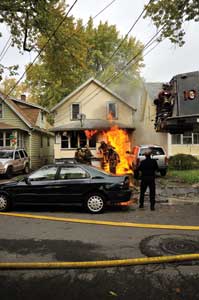By John F. “Skip” Coleman, Technical Editor
We now know and can document that smoke is bad for us. We also have learned and documented that some of the particles in smoke cling to our bunker gear for days. So, if we simply put our bunker gear back on without cleaning it from the last fire even days later, we can still inhale/absorb those harmful particles.
Roundtable question: Does your department require that you clean bunker gear after every working fire? To post your comments, go to fireengineering.com/roundtable.html.
WEBCASTS
Join us for monthly Webcasts featuring the best of Fire Engineering authors and FDIC speakers. On December 19, Lieutenant Brian Brush from West Metro (CO) Fire Rescue will present “Missing Pieces of Firefighter Survival,” focusing on the realities of the firefighter survival situations, the body’s responses to stress, and how to build resilience to these stressors. Webcasts are free, but you must register. If you miss this or any other Webcasts, they are archived on emberly.fireengineering.com for six months.
FIRE LIFE
Once again, Anne Gagliano hits the nail on the head in her column “What Every Firefighter’s Spouse Should Know.” In her article “Who Gets Your Best?” she writes: “Many things remain undone by the end of the day as they simply didn’t fit into our schedule for one reason or another. Priorities, energy, time-how do we pick and choose? We do so by daily asking, ‘Who gets your best … your best efforts … your best attention … your best treatment?’ ” Read this column and more on the firefighter lifestyle, only at www.firelife.com.
 |
| PHOTO OF THE DAY: As Buffalo (NY) firefighters were knocking down this fire, a five-gallon container of gasoline stored in the porch tipped over and ignited, briefly engulfing two members. Because of their protective gear, they were not seriously hurt. (Photo by Kevin Brautlacht.) See more photos at http://emberly.fireengineering.com/photo-of-the-day.html. Send your Photo of the Day submissions to Peter Prochilo (peterp@pennwell.com). |
FEATURED ARTICLES
David Dalrymple writes in “Glass Management: Rescuers’ Building Blocks”: “At all the extrication programs you attend, you are taught to remove glass as needed and in as controlled a manner as practical and possible. However, how many times do you attend the practical session and WHAM … SMASH goes the side and rear glass because it’s impressive to visually observe? Is that really what you should be doing?” (http://bit.ly/1atRFZ0)
Jeremy Jones writes in “The Violent Confrontation”: “Does your department have a preplan in place for a violent confrontation on the fireground? If your policy is simply to call the police for assistance, that just isn’t good enough. Remember, when seconds count, the police are only minutes away. You or someone from your crew will have to deal with this problem in some shape or form for a period of time until help arrives.” (http://bit.ly/HbRXL6)
George H. Potter writes in “Mass Casualty Incident: Spanish Train Derailment, Parts 1 and 2”: “Mass casualty incidents can be pure nightmares for emergency responders if they are not prepared for the multiple demands of human and material resources, command structure, communications, and support measures that will be necessary to manage and resolve the situation smoothly and safely.” (http://bit.ly/1ioH6t0) (http://bit.ly/1bv0fac)
Jarrod Sergi writes in “Lack of Ventilation Because of a Lack of Performance”: “Ventilation is a critical fireground tactic that must be performed not only to save trapped occupants but also to allow the engine company to quickly make a push to the seat of the fire. I have talked to firefighters from departments all over the country who say that vertical ventilation is going away or that it’s becoming a lost art.” (http://bit.ly/Hr4dap)
Becki White writes in “The True Meaning of Public Education”: “There are three ways to reach out to the public: public relations, public information, and public education. Anything you do as a member of your community fire department falls into one of those categories, whether you think you’re representing the department or not.” (http://bit.ly/17nzsQf)
COMMUNITY MEMBER OF THE MONTH |
||
|
Name: Joseph Viscuso. Department: Kearny (NJ) Fire Department. Rank: deputy chief. Years of public service: 20. Agency structure: paid department. Top issue in your department: training. Professional qualifications: level II instructor. Topic you provide training for: the dangers of rooftop cellular base stations. |
 |
|
Fire Engineering Archives


